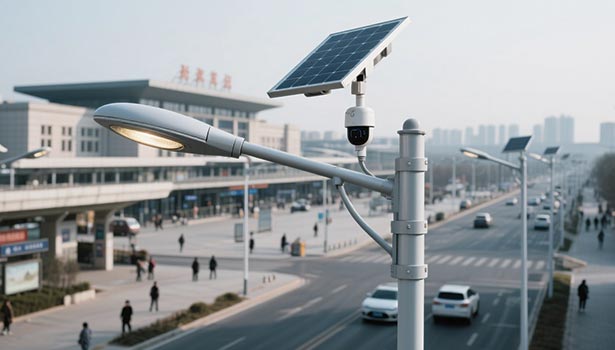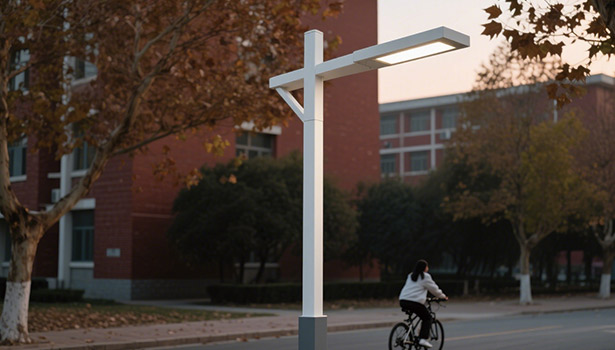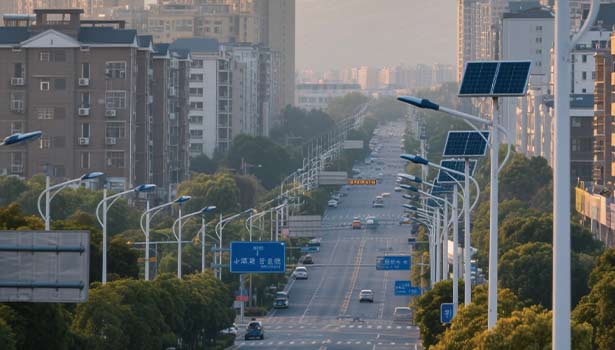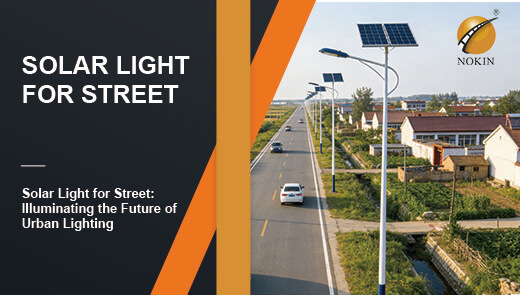How to Evaluate the Lighting Performance of Solar Street Lights?
At a time when the concept of energy saving and environmental protection is becoming more and more in-depth, solar street lamps play a key role in urban and rural lighting, and the advantages and disadvantages of its lighting performance not only affects the safety of nighttime traffic, but also relates to the efficiency of energy utilization, so how to scientifically assess its lighting performance has become a problem worthy of in-depth discussion.

Understanding the Importance of Solar Street Light Performance
In modern urban and rural lighting systems, solar street lights are becoming increasingly important. In modern urban and rural lighting systems, solar street lights are becoming more and more important due to their energy-saving and environmentally friendly features and the fact that they do not require complex wiring. Evaluating the lighting performance of solar street lights is of vital significance for practical application, which not only ensures the safety of road traffic at night and allows pedestrians and vehicles to pass smoothly under a clear lighting environment, but also improves the lighting efficiency, avoids the waste of energy, and contributes to the sustainable development.
Key Factors Affecting the Lighting Performance of Solar Street Lights
Project Budget
Although the overall project cost of solar street lights has a cost advantage over grid-supplied street lights, the unit cost is higher because they need to be equipped with additional solar panels, batteries, mounting brackets and other components. While solar street lights have a cost advantage over grid-supplied street lights overall, the unit cost is higher because they require additional components such as solar panels, batteries, mounting brackets, etc., and the poles are usually larger. The cost of grid-supplied street lights is mainly in underground wiring, protective conduit installation and trenching. If the budget for grid street lights in these areas can be allocated to component upgrades for solar street lights, their performance can be significantly improved.
Increasing the capacity of solar panels and batteries to store more power, and choosing high-efficiency LED fixtures to improve the brightness and stability of the light, so that the solar street lamp lighting performance to meet or even exceed the grid-supplied street lamps. On the contrary, if the budget allocation is not reasonable, excessive compression of the core component costs will directly lead to the solar panel power generation efficiency is not enough, the battery storage capacity is not enough, the lamps and lanterns brightness is low and other problems, seriously affect the overall lighting effect.
Configuration Parameters
In many cases, the project owner will prioritize the specifications of the light poles but neglect the importance of the solar panels, batteries and LED lamps, which will lead to irrational allocation of funds and negatively affect the overall lighting performance. The system configuration of solar street light is not determined arbitrarily, but needs to be decided according to the power consumption, daily sunshine and environmental factors. This is a highly professional work, which is best done by an experienced manufacturer to ensure the rationality and optimization of the configuration.
Only when the parameters of each component are matched with each other and adapted to the actual use scenario can the lighting performance of the solar street light be fully utilized, otherwise problems such as insufficient power generation, insufficient power storage or poor lighting effect may occur.
Environmental and Geographical Factors
Solar street lights are completely dependent on solar power, so their performance is closely related to sunlight conditions. In many areas, the sunlight hours in the fall and winter seasons are insufficient, which brings challenges to the normal operation of solar street lights. In order to solve this problem, related companies have developed a long-lasting rainy weather solar street light system, which improves charging efficiency in low-light environments and ensures that even in areas with limited sunlight, solar street lights can operate uninterruptedly throughout the year while maintaining good lighting performance.
For example, solar street light models with high-efficiency monocrystalline silicon solar panels have achieved excellent results in both field tests and actual applications. In addition, different geographic environments, such as foggy and dusty areas, can also affect solar energy absorption, which in turn affects the street light's lighting performance.

Manufacturer Expertise
To ensure that solar street lights have good lighting performance, a high specification system is needed, and the larger the system, the higher the technical requirements, so it is crucial to choose a professional manufacturer, who can, with their professional technology and experience, carry out scientific design in terms of component selection, system integration, performance optimization, etc., and produce products that meet the different scenarios' lighting They can make scientific design in component selection, system integration, performance optimization and other aspects with professional technology and experience to produce products to meet the lighting needs of different scenes, while unprofessional manufacturers may cause unstable product performance due to the lack of technology and greatly reduce the lighting effect.
How to Assess the Lighting Performance of Solar Street Lights?
Solar Panel Efficiency
How much energy a solar panel can produce is the most important indicator when assessing a solar street light. High efficiency means better energy output, especially on cloudy days or shorter daylight hours. High efficiency means better energy output, especially on cloudy days or days with short daylight hours. The test method is to measure the output of the solar panel at the peak of sunlight, you can use a solar meter to measure the intensity of the light received by the solar panel and the energy produced, by comparing the energy output of different solar panels under the same lighting conditions, you can intuitively determine its efficiency.
Battery Performance and Storage Capacity
The role of the battery is to store the energy generated by the solar panel for the street light to be used at night, the performance of the battery determines how long the street light can run after sunset. The test method is to measure the discharge rate of the battery to ensure that it meets the lighting requirements of the area where it is located, such as how long the street light can continue to illuminate at night with sufficient brightness. At the same time, it is also important to pay attention to the cycle life of the battery. The higher the number of cycles, the better the storage performance of the battery over a longer period of time, which ensures the stable operation of the street light in the long term.
Lighting Output (Lumen)
Lumen is a unit of light brightness, and the lighting output (lumen) of a solar street light directly affects its effectiveness in illuminating streets and related areas. A light meter is used to measure the lumen produced by the solar lamp to ensure that the output is appropriate for the area to be illuminated. Different application scenarios have different lumen requirements, e.g. main roads require higher lumen to ensure traffic safety, while small alleys can be lowered appropriately, so it is necessary to assess whether the lighting output meets the standard according to the actual needs.
Duration and Battery Life
Solar street lights need to operate consistently and stably at night and not show significant performance degradation over a period of several years. Tests include continuous lighting tests, observing how long the street light stays lit after a single charge, and tracking the loss of battery capacity over time to estimate the expected lifetime of the system. If a street light does not stay lit overnight after a single charge, or if the battery capacity drops dramatically over a short period of time, there is a problem with its lighting performance.
Durability and Weather Resistance
Since solar street lights are installed outdoors, the ability to resist weather conditions such as rain, heat and humidity is critical. The materials used in the lamps and poles are tested for corrosion and abrasion resistance, and IP protection ratings are checked to assess the street light's ability to resist dust, moisture, and a variety of weather conditions. Highly durable and weather-resistant solar street lights maintain consistent lighting performance in harsh environments, reducing maintenance costs and replacement frequency.

Smart Features and Integration
Nowadays, more and more solar street lights are equipped with smart features such as motion sensors or adaptive lighting based on traffic conditions. These smart features need to be tested in a real-time environment, e.g. to measure how the motion sensor reacts to changes in movement or to see if the adaptive lighting adjusts appropriately to changes in the environment.Good operation of intelligent functions can further optimize the lighting effect and improve the energy use efficiency, while the overall lighting performance will be affected if the intelligent functions are slow to respond or improperly adjusted.
Practical Suggestions for Improving the Lighting Performance of Solar Street Lights
Do a Good Job of Pre-Planning
In the early stages of the project, it is necessary to conduct field inspections of the installation area's year-round sunshine hours, the frequency of extreme weather, combined with the width of the road, the flow of people, and other lighting needs, to ensure that the system configuration accurately matches the scenario, and to avoid from the source the performance problems caused by the “small horse-drawn cart” or over-configuration Focus on component quality selection.
Focusing on Component Quality Selection
Prioritizes the selection of monocrystalline silicon solar panels with a conversion efficiency of over 22%, lithium iron phosphate batteries with a cycle life of more than 2,000 times, and LED lamps with a luminous efficacy of ≥130lm/W. At the same time, the manufacturer is required to provide a compatibility test report for the components, so as to avoid energy loss in the power generation, power storage, and lighting segments due to the mismatch of parameters.
Regular Maintenance
Monthly cleaning of the solar panel surface of dust, bird droppings and other obstructions, especially in foggy, dusty areas need to increase the frequency; Quarterly testing of battery charging and discharging efficiency, found that the capacity of more than 20% capacity degradation in a timely manner to replace; Every half a year overhaul of the lamps and lanterns heat dissipation system, to ensure that the light degradation control in the annual ≤ 5%, to maintain a stable lighting output.
Introducing Intelligent Control System
Equipped with light sensor and microwave radar, realizing “automatically turn on the lights in the dark, automatically turn off the lights at dawn”, and automatically adjusting the brightness according to the number of vehicles and pedestrians, together with the remote monitoring platform to monitor the status of the equipment in real time, and timely warning of failures, which reduces the energy consumption by more than 30% while guaranteeing the lighting demand.
Evaluating the lighting performance of a solar street light requires taking into account a number of factors, and through rational planning, selecting components, regular maintenance and incorporating intelligent features, the performance can be effectively enhanced, allowing solar street lights to play a greater role in sustainable lighting.




